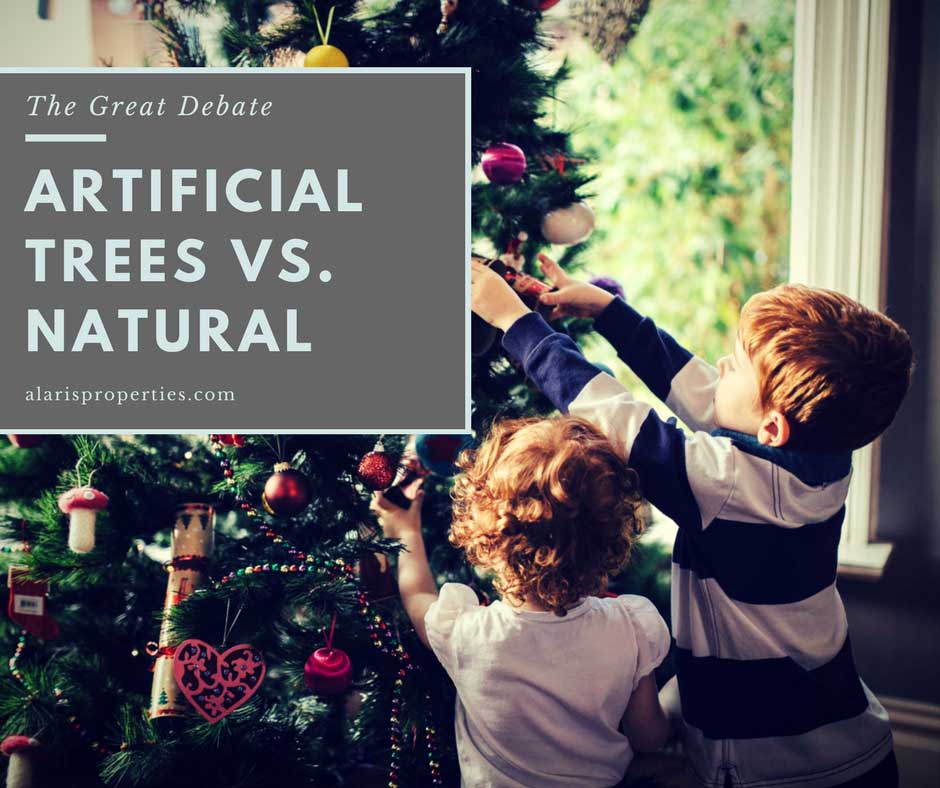
It’s the most wonderful time of the year. Well, almost. And with the cold winter chill, it’s time to decorate for the holiday season. The most important decoration is, of course, the piece de resistance: Your Christmas tree. And it’s a bigger decision than you might think. Some are Christmas tree purists — real trees only, thank you — while others see the benefit of a tasteful artificial tree. Check out our list of pros and cons to find out which one is right for you (and to settle this great debate once and forall).
Artificial Trees
Pros:
Longevity
If taken care of properly, artificial Christmas trees can last through several holiday seasons — sometimes more than 10 years. While a real tree is a yearly purchase, an artificial tree is more like a long-term investment, and being able to pull out the same tree every year will save your family time and money in the long run.
Low Maintenance
One of the biggest benefits of having an artificial tree is the lack of upkeep. There’s no watering and, best of all, put those vacuums away because there is no needle clean-up required. Plus, you don’t need to take the time to go out and pick out a tree every year. It’s always right there at the back of your closet or in your garage.
Easy to Decorate
Many artificial Christmas trees are pre-lit, which will save you a lot of time and energy when it’s time to decorate. That way, you can focus on the ornaments, the star, and your family’s favorite tree-trimming traditions. Pre-lit trees really cut the take-down time too, which is great because, let’s face it — we all procrastinate taking down the tree.
Cons:
Environmental Impact
You might think that cutting down a real tree would be worse for the environment than buying a fake one, but that’s actually not the case. Most artificial Christmas trees are made of polyvinyl chloride, which is a toxic, non-recyclable plastic. The factories that produce these trees also use large amounts of energy and create additional pollution, so in the long run, buying a real tree might actually be the more environmentally friendly choice.
Not Local
More than 85 percent of artificial Christmas trees sold in the U.S. are imported from China, which means that it’s more difficult to buy locally. If you’re dead set on buying an artificial tree this year, look for local retailers that sell trees made in the U.S. In the Denver area, we suggest LeGrue’s Christmas.
Fire Hazard
A 2010 study found that artificial Christmas trees can be just as much of a fire hazard as a natural tree that has become dried out. The difference, though, is that with a real tree you can reduce the risk by keeping your tree properly watered. Though fire safety should always be a priority, make sure to check all of your Christmas lights for cracks and be careful of any candles near the tree — the risk of an artificial tree is important to acknowledge
Natural Trees
Pros:
Family Traditions
For many families, heading out to pick the Christmas tree is a favorite holiday tradition. It’s an opportunity for your family to spend time together and get into the Christmas spirit as you begin to prepare for the season. The fresh pine smell will also fill your home with the scent of the season, making it feel even more festive (don’t get me wrong, pine scented candles are wonderful, but they don’t do justice compared to the real thing).
Environmental Impact
Christmas tree farms actually provide habitats for animals, which helps support your local ecosystem. Once it’s in your home, the tree continues to produce oxygen, so you are creating fresh air right in your house. Plus, once you’re ready to take the tree down for the season, it can be recycled for mulch, which means there’s no negative environmental impact after Christmas is over.
Good for the Local Economy
Most Christmas trees are grown by U.S. farmers, which means that when you buy a tree, you’re supporting a local business. Many farms rely on the business that comes in during this time of year, and your purchase is a great way to contribute to the local economy. Check out this list of Christmas tree farms in Colorado to buy yours locally this year.
Cons:
The Cost
Most real Christmas trees cost at least $50, which some would say is a big investment for something that will only last a month. When you add that to all of the other expenses of the holiday season, like gifts, travel and holiday meals, it all piles up quickly. The cost of buying a tree year after year is also much higher than the one-time investment of an artificial tree.
The Mess
Real trees may add extra cheer to your home, but they also add extra chores. Living trees need upkeep, so you’ll have to take the time to water your tree and clean up any fallen needles, especially since they can be a choking hazard for younger children. If you have pets, keeping them away from the tree can be a difficult task, too.
The Hassle
Going to pick out your own tree might seem like a fun family activity, but in reality, it will probably involve a lot of bungee cords and unwanted sap à la “Christmas Vacation.” Once you find a tree, you’ve got to strap it to your car and wrestle it into the house, only to do it again in a month when the holidays are over. Plus, you’ve got to find somewhere to take it once it’s finally taken down. That’s a lot of effort.
The question of whether to buy a real or artificial tree this year might not be as simple as you thought, but now that you’ve seen the pros and cons, your decision will at least be an informed one. The holidays are right around the corner — so go get that tree and get ready to celebrate.



